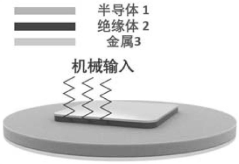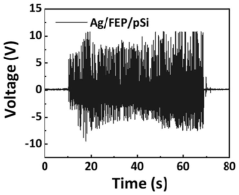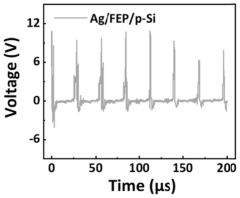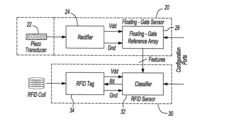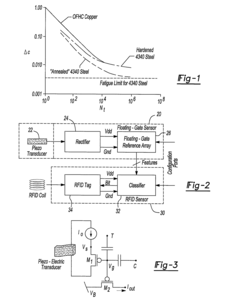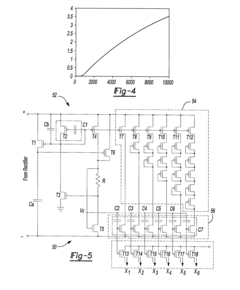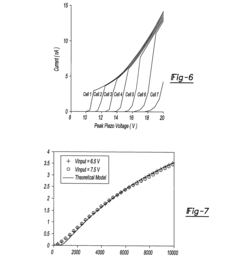Development of Semiconductor-Based Self-Powered Sensors
OCT 21, 20259 MIN READ
Generate Your Research Report Instantly with AI Agent
Patsnap Eureka helps you evaluate technical feasibility & market potential.
Semiconductor Sensor Evolution and Objectives
Semiconductor-based sensors have undergone a remarkable evolution since their inception in the mid-20th century. The journey began with simple silicon-based devices capable of measuring basic physical parameters, gradually advancing to today's sophisticated multi-functional sensing platforms. The initial breakthrough came with the development of the first silicon strain gauge in the 1950s, which laid the foundation for semiconductor sensing technology. By the 1970s, integrated circuit technology enabled the miniaturization of sensors, significantly expanding their application scope.
The 1990s witnessed a paradigm shift with the emergence of MEMS (Micro-Electro-Mechanical Systems) technology, which facilitated the integration of mechanical elements, sensors, actuators, and electronics on a common silicon substrate. This integration dramatically reduced sensor size, power consumption, and cost while improving performance metrics. The early 2000s saw further advancements with the introduction of CMOS-compatible sensor fabrication processes, enabling seamless integration with signal processing circuitry.
Recent years have been characterized by the convergence of semiconductor sensors with emerging technologies such as IoT, AI, and edge computing. This convergence has driven the development of intelligent sensor systems capable of not just data acquisition but also local processing and decision-making. The current technological frontier focuses on self-powered semiconductor sensors that can harvest energy from their environment, eliminating the need for external power sources and enabling truly autonomous operation.
The primary objective of semiconductor-based self-powered sensor development is to create sensing devices that can operate indefinitely without battery replacement or external power supply. This involves integrating energy harvesting mechanisms—such as piezoelectric, thermoelectric, or photovoltaic elements—directly with sensing components on a single semiconductor platform. The goal is to achieve a balanced energy profile where the harvested energy meets or exceeds the sensor's operational requirements.
Secondary objectives include enhancing sensitivity and selectivity while maintaining ultra-low power consumption, developing robust packaging solutions for harsh environments, and ensuring long-term reliability. There is also a strong focus on scalable manufacturing processes to enable cost-effective mass production. The ultimate vision is to enable ubiquitous sensing capabilities for applications ranging from environmental monitoring and infrastructure health assessment to medical diagnostics and smart agriculture.
The technological trajectory points toward increasingly integrated, miniaturized, and functionally diverse sensor platforms that can operate autonomously in various environments. As semiconductor fabrication techniques continue to advance, we anticipate further breakthroughs in materials, device architectures, and energy harvesting efficiencies, ultimately leading to truly self-sustaining sensing systems.
The 1990s witnessed a paradigm shift with the emergence of MEMS (Micro-Electro-Mechanical Systems) technology, which facilitated the integration of mechanical elements, sensors, actuators, and electronics on a common silicon substrate. This integration dramatically reduced sensor size, power consumption, and cost while improving performance metrics. The early 2000s saw further advancements with the introduction of CMOS-compatible sensor fabrication processes, enabling seamless integration with signal processing circuitry.
Recent years have been characterized by the convergence of semiconductor sensors with emerging technologies such as IoT, AI, and edge computing. This convergence has driven the development of intelligent sensor systems capable of not just data acquisition but also local processing and decision-making. The current technological frontier focuses on self-powered semiconductor sensors that can harvest energy from their environment, eliminating the need for external power sources and enabling truly autonomous operation.
The primary objective of semiconductor-based self-powered sensor development is to create sensing devices that can operate indefinitely without battery replacement or external power supply. This involves integrating energy harvesting mechanisms—such as piezoelectric, thermoelectric, or photovoltaic elements—directly with sensing components on a single semiconductor platform. The goal is to achieve a balanced energy profile where the harvested energy meets or exceeds the sensor's operational requirements.
Secondary objectives include enhancing sensitivity and selectivity while maintaining ultra-low power consumption, developing robust packaging solutions for harsh environments, and ensuring long-term reliability. There is also a strong focus on scalable manufacturing processes to enable cost-effective mass production. The ultimate vision is to enable ubiquitous sensing capabilities for applications ranging from environmental monitoring and infrastructure health assessment to medical diagnostics and smart agriculture.
The technological trajectory points toward increasingly integrated, miniaturized, and functionally diverse sensor platforms that can operate autonomously in various environments. As semiconductor fabrication techniques continue to advance, we anticipate further breakthroughs in materials, device architectures, and energy harvesting efficiencies, ultimately leading to truly self-sustaining sensing systems.
Market Analysis for Self-Powered Sensing Solutions
The self-powered sensing solutions market is experiencing robust growth driven by increasing demand for autonomous and maintenance-free sensing systems across multiple industries. Current market valuations indicate that the global self-powered sensors market reached approximately 6.5 billion USD in 2022 and is projected to grow at a compound annual growth rate (CAGR) of 12.8% through 2030. This growth trajectory is significantly outpacing traditional sensor markets, which typically grow at 7-9% annually.
The semiconductor-based self-powered sensors segment represents the fastest-growing category within this market, with energy harvesting technologies such as piezoelectric, triboelectric, thermoelectric, and photovoltaic solutions leading adoption rates. Industrial IoT applications currently constitute the largest market share at 34%, followed by consumer electronics (28%), automotive (18%), healthcare (12%), and other applications (8%).
Regional analysis reveals that North America currently holds the largest market share at approximately 38%, followed by Europe (27%), Asia-Pacific (25%), and rest of the world (10%). However, the Asia-Pacific region is expected to witness the highest growth rate over the next five years due to rapid industrialization, smart city initiatives, and increasing IoT adoption in countries like China, Japan, South Korea, and India.
Key market drivers include the proliferation of IoT devices requiring autonomous power sources, increasing focus on sustainable and maintenance-free sensing solutions, miniaturization of electronic components, and advancements in low-power semiconductor technologies. The industrial sector shows particularly strong demand for self-powered sensors in predictive maintenance, structural health monitoring, and process optimization applications.
Consumer demand patterns indicate growing preference for "set-and-forget" sensing solutions that eliminate battery replacement requirements. This trend is especially pronounced in hard-to-reach deployment scenarios such as infrastructure monitoring, remote environmental sensing, and implantable medical devices.
Market challenges include relatively higher initial costs compared to traditional battery-powered sensors, performance limitations in energy-scarce environments, and integration complexities with existing systems. Despite these challenges, the long-term total cost of ownership advantages and maintenance-free operation continue to drive adoption.
Emerging market opportunities exist in wearable health monitoring, smart agriculture, building automation, and environmental monitoring sectors. The convergence of semiconductor-based self-powered sensors with edge computing capabilities and AI-driven analytics represents a particularly promising growth avenue, enabling new applications that were previously impractical due to power constraints.
The semiconductor-based self-powered sensors segment represents the fastest-growing category within this market, with energy harvesting technologies such as piezoelectric, triboelectric, thermoelectric, and photovoltaic solutions leading adoption rates. Industrial IoT applications currently constitute the largest market share at 34%, followed by consumer electronics (28%), automotive (18%), healthcare (12%), and other applications (8%).
Regional analysis reveals that North America currently holds the largest market share at approximately 38%, followed by Europe (27%), Asia-Pacific (25%), and rest of the world (10%). However, the Asia-Pacific region is expected to witness the highest growth rate over the next five years due to rapid industrialization, smart city initiatives, and increasing IoT adoption in countries like China, Japan, South Korea, and India.
Key market drivers include the proliferation of IoT devices requiring autonomous power sources, increasing focus on sustainable and maintenance-free sensing solutions, miniaturization of electronic components, and advancements in low-power semiconductor technologies. The industrial sector shows particularly strong demand for self-powered sensors in predictive maintenance, structural health monitoring, and process optimization applications.
Consumer demand patterns indicate growing preference for "set-and-forget" sensing solutions that eliminate battery replacement requirements. This trend is especially pronounced in hard-to-reach deployment scenarios such as infrastructure monitoring, remote environmental sensing, and implantable medical devices.
Market challenges include relatively higher initial costs compared to traditional battery-powered sensors, performance limitations in energy-scarce environments, and integration complexities with existing systems. Despite these challenges, the long-term total cost of ownership advantages and maintenance-free operation continue to drive adoption.
Emerging market opportunities exist in wearable health monitoring, smart agriculture, building automation, and environmental monitoring sectors. The convergence of semiconductor-based self-powered sensors with edge computing capabilities and AI-driven analytics represents a particularly promising growth avenue, enabling new applications that were previously impractical due to power constraints.
Current Challenges in Energy Harvesting Semiconductors
Despite significant advancements in semiconductor-based self-powered sensors, energy harvesting semiconductors face several critical challenges that impede their widespread adoption and optimal performance. The primary obstacle remains the limited energy conversion efficiency, particularly in ambient energy harvesting scenarios where energy sources are typically diffuse and intermittent. Most current semiconductor-based harvesters operate at efficiency levels below 30%, with many practical implementations achieving only 5-15% efficiency under real-world conditions.
Miniaturization presents another significant challenge, as reducing device dimensions often leads to decreased energy output. This creates a fundamental tension between the desire for smaller, less intrusive sensors and the need for sufficient power generation. The power density of current semiconductor energy harvesters typically ranges from 10 μW/cm² to 1 mW/cm², which proves inadequate for many higher-power sensing applications.
Material stability and degradation issues also plague semiconductor-based energy harvesting systems. Environmental factors such as temperature fluctuations, humidity, and mechanical stress can significantly reduce device lifespan and performance reliability. Many current materials exhibit performance degradation of 10-20% after just one year of operation, necessitating frequent replacement or maintenance.
The integration of energy harvesting semiconductors with power management circuits and energy storage components remains technically challenging. Impedance matching between harvesters and power conditioning circuits is particularly problematic, often resulting in energy losses of 30-40% during the power transfer process. Additionally, the intermittent nature of harvested energy requires sophisticated power management strategies to ensure stable sensor operation.
Cost-effectiveness represents another major hurdle, with current manufacturing processes for high-efficiency semiconductor harvesters being prohibitively expensive for mass-market applications. Production costs for specialized semiconductor energy harvesters can be 5-10 times higher than conventional power sources, limiting their commercial viability.
Cross-domain compatibility issues arise when attempting to integrate semiconductor energy harvesters with existing sensor platforms and communication protocols. Many current designs require custom interfaces and specialized components, complicating system integration and increasing overall complexity and cost.
Finally, the lack of standardization in testing methodologies and performance metrics makes it difficult to compare different energy harvesting solutions objectively. This absence of industry standards hampers technology evaluation and slows adoption rates across various application domains, creating uncertainty for potential implementers and investors in this promising technology area.
Miniaturization presents another significant challenge, as reducing device dimensions often leads to decreased energy output. This creates a fundamental tension between the desire for smaller, less intrusive sensors and the need for sufficient power generation. The power density of current semiconductor energy harvesters typically ranges from 10 μW/cm² to 1 mW/cm², which proves inadequate for many higher-power sensing applications.
Material stability and degradation issues also plague semiconductor-based energy harvesting systems. Environmental factors such as temperature fluctuations, humidity, and mechanical stress can significantly reduce device lifespan and performance reliability. Many current materials exhibit performance degradation of 10-20% after just one year of operation, necessitating frequent replacement or maintenance.
The integration of energy harvesting semiconductors with power management circuits and energy storage components remains technically challenging. Impedance matching between harvesters and power conditioning circuits is particularly problematic, often resulting in energy losses of 30-40% during the power transfer process. Additionally, the intermittent nature of harvested energy requires sophisticated power management strategies to ensure stable sensor operation.
Cost-effectiveness represents another major hurdle, with current manufacturing processes for high-efficiency semiconductor harvesters being prohibitively expensive for mass-market applications. Production costs for specialized semiconductor energy harvesters can be 5-10 times higher than conventional power sources, limiting their commercial viability.
Cross-domain compatibility issues arise when attempting to integrate semiconductor energy harvesters with existing sensor platforms and communication protocols. Many current designs require custom interfaces and specialized components, complicating system integration and increasing overall complexity and cost.
Finally, the lack of standardization in testing methodologies and performance metrics makes it difficult to compare different energy harvesting solutions objectively. This absence of industry standards hampers technology evaluation and slows adoption rates across various application domains, creating uncertainty for potential implementers and investors in this promising technology area.
State-of-the-Art Self-Powering Mechanisms
01 Energy harvesting mechanisms for self-powered sensors
Semiconductor-based self-powered sensors can utilize various energy harvesting mechanisms to generate power for operation. These mechanisms include piezoelectric, triboelectric, photovoltaic, and thermoelectric effects that convert ambient energy into electrical power. By integrating these energy harvesting components with sensing elements, the sensors can operate autonomously without external power sources, making them suitable for remote monitoring applications and IoT devices.- Energy harvesting mechanisms for self-powered sensors: Semiconductor-based self-powered sensors can utilize various energy harvesting mechanisms to generate power for operation. These mechanisms include piezoelectric, triboelectric, thermoelectric, and photovoltaic effects that convert ambient energy into electrical power. By integrating these energy harvesting components with sensing elements, the sensors can operate autonomously without external power sources, making them suitable for remote monitoring applications and IoT devices.
- Semiconductor materials for self-powered sensing: Various semiconductor materials are employed in self-powered sensors to achieve both energy harvesting and sensing functionalities. Materials such as zinc oxide, gallium nitride, silicon, and compound semiconductors exhibit properties that enable efficient conversion of environmental stimuli into electrical signals. These materials can be engineered at the nanoscale to enhance their sensitivity and energy conversion efficiency, allowing for the development of highly responsive self-powered sensing systems.
- Structural designs for integrated sensing and power generation: Innovative structural designs are crucial for integrating sensing and power generation capabilities in semiconductor-based self-powered sensors. These designs include flexible substrates, 3D architectures, and micro/nanostructured arrays that maximize energy harvesting while maintaining sensing performance. The integration of multiple functional layers and careful consideration of interface engineering enables efficient charge transfer and signal transduction, resulting in reliable and sensitive self-powered sensing systems.
- Signal processing and wireless communication integration: Advanced signal processing techniques and wireless communication capabilities are integrated into semiconductor-based self-powered sensors to enhance their functionality. These systems incorporate low-power microcontrollers, signal conditioning circuits, and wireless transmission modules that operate efficiently with the limited power generated by the energy harvesting components. The integration of these elements enables real-time data acquisition, processing, and transmission while maintaining energy autonomy.
- Applications in environmental and biomedical monitoring: Semiconductor-based self-powered sensors find diverse applications in environmental and biomedical monitoring. These sensors can detect various parameters such as temperature, humidity, pressure, gas concentration, and biological markers without requiring battery replacement or external power sources. Their autonomous operation makes them particularly valuable for long-term monitoring in remote locations, wearable health devices, implantable medical sensors, and environmental monitoring networks where regular maintenance is challenging.
02 Semiconductor materials for self-powered sensing
Various semiconductor materials are employed in self-powered sensors to achieve both energy generation and sensing capabilities. Materials such as zinc oxide, gallium nitride, silicon, and compound semiconductors exhibit properties that allow them to convert physical stimuli into electrical signals while simultaneously generating power. The selection of appropriate semiconductor materials is crucial for optimizing the sensitivity, power generation efficiency, and overall performance of self-powered sensors.Expand Specific Solutions03 Structural designs for enhanced performance
Innovative structural designs are implemented in semiconductor-based self-powered sensors to enhance their performance. These designs include nanowire arrays, thin films, heterojunctions, and micro-electromechanical systems (MEMS) that maximize energy harvesting efficiency and sensing capabilities. By optimizing the physical structure of the sensors, parameters such as sensitivity, response time, and power output can be significantly improved for various applications.Expand Specific Solutions04 Integration with wireless communication systems
Self-powered semiconductor sensors are often integrated with wireless communication systems to enable remote data transmission without external power sources. These integrated systems combine energy harvesting, sensing, and communication functionalities in a single device. Various wireless protocols such as Bluetooth, ZigBee, and LoRa are utilized depending on the application requirements, allowing for real-time monitoring and data collection in diverse environments.Expand Specific Solutions05 Applications in environmental and biomedical monitoring
Semiconductor-based self-powered sensors find extensive applications in environmental and biomedical monitoring. These sensors can detect parameters such as temperature, humidity, gas concentration, pressure, and biological signals without requiring battery replacement or external power. Their autonomous operation makes them particularly valuable for long-term monitoring in remote locations, wearable health devices, implantable medical sensors, and environmental monitoring systems where regular maintenance is challenging.Expand Specific Solutions
Leading Companies in Semiconductor Sensing Industry
The semiconductor-based self-powered sensor market is in a growth phase, characterized by increasing applications in IoT, wearables, and industrial monitoring. The global market is projected to reach significant scale as energy harvesting technologies mature. Leading companies like Samsung Electronics, Texas Instruments, and Infineon Technologies are driving innovation with advanced sensor designs and energy harvesting solutions. Academic institutions including Chongqing University and Case Western Reserve University contribute fundamental research, while specialized firms like Gentle Energy Corp. focus on energy capture technologies. The competitive landscape features both established semiconductor manufacturers and emerging players, with collaboration between industry and academia accelerating technological advancement toward commercial viability.
Infineon Technologies AG
Technical Solution: Infineon has pioneered semiconductor-based self-powered sensors through their innovative "Zero Power" technology platform. Their approach combines highly efficient energy harvesting circuits with ultra-low-power sensing elements and specialized power management ICs. Infineon's self-powered sensors utilize a variety of energy sources including light, vibration, temperature gradients, and RF signals, with their proprietary converter circuits achieving harvesting efficiencies exceeding 85% across wide input ranges[5]. A key innovation in Infineon's technology is their use of ferroelectric materials integrated directly into CMOS processes, enabling sensors that can both harvest energy and detect physical parameters using the same active element. Their sensors incorporate specialized wake-up circuits that remain dormant until triggered by specific environmental conditions, consuming virtually zero standby power. Infineon has demonstrated self-powered wireless sensor nodes that can operate perpetually in industrial environments by harvesting energy from machinery vibrations and thermal gradients, with their specialized power management circuits storing excess energy in supercapacitors for periods of high activity[6].
Strengths: Infineon's extensive experience in power semiconductors enables highly efficient energy harvesting and power management. Their automotive-grade manufacturing capabilities ensure reliability in harsh environments. Weaknesses: Their solutions often require specialized semiconductor processes that may increase production costs, and the current technology has limitations in very low-energy environments where harvesting opportunities are minimal.
DENSO Corp.
Technical Solution: DENSO has developed advanced semiconductor-based self-powered sensors specifically optimized for automotive and industrial applications. Their technology leverages thermoelectric generators (TEGs) and vibration-based energy harvesters integrated with specialized automotive-grade semiconductor sensors. DENSO's approach focuses on harvesting energy from the abundant thermal gradients and vibrations present in vehicles and industrial machinery. Their self-powered sensors utilize custom-designed power management ICs that can efficiently extract energy from sources with highly variable characteristics, such as engine vibrations that change with RPM. A key innovation in DENSO's technology is their integration of multiple energy harvesting modalities that work synergistically, allowing the sensors to operate across diverse environmental conditions. Their sensors incorporate specialized wake-up circuits that can detect specific events (such as acceleration or temperature thresholds) while consuming nanowatts of power. DENSO has demonstrated self-powered tire pressure monitoring systems that harvest energy from tire deformation during rotation, eliminating the need for batteries that typically require replacement every few years[9]. Their technology also includes self-powered exhaust gas sensors that operate using the thermal gradient between exhaust gases and ambient air, enabling continuous monitoring without external power[10].
Strengths: DENSO's extensive automotive experience ensures their sensors meet stringent reliability and durability requirements for harsh environments. Their specialized energy harvesting techniques are highly optimized for specific applications, maximizing efficiency. Weaknesses: Their solutions are often highly specialized for particular applications rather than being general-purpose, potentially limiting broader market adoption. The current technology also has limitations in applications with minimal thermal gradients or vibration.
Key Patents in Energy Harvesting Semiconductor Sensors
Self-driven mechanical signal sensor based on dynamic diode and preparation method thereof
PatentActiveCN115290953A
Innovation
- Design a dynamic diode self-driven mechanical signal sensor based on semiconductor/insulator/metal. Through the thermal electron transition, rebound, and transport mechanism, the mechanical signal is converted into a same-frequency electrical signal output, and the potential difference between the metal and the semiconductor is used to stimulate High-energy hot electrons pass through the insulation layer to form ultra-fast electrical signal output.
Self-powered sensor
PatentActiveUS8056420B2
Innovation
- A self-powered sensor system utilizing a piezoelectric transducer, a non-volatile memory with floating gate transistors, and a current reference circuit that operates in weak-inversion mode, allowing for energy harvesting and efficient storage and computation, while maintaining low power dissipation.
Materials Science Advancements for Energy Efficiency
Recent advancements in materials science have significantly propelled the development of semiconductor-based self-powered sensors toward greater energy efficiency. The evolution of nanomaterials, particularly piezoelectric and triboelectric materials, has enabled the creation of sensors that can harvest ambient energy while simultaneously performing sensing functions. Silicon carbide (SiC) and gallium nitride (GaN) have emerged as particularly promising wide-bandgap semiconductors, offering superior thermal conductivity and breakdown voltage compared to traditional silicon, thereby enhancing energy conversion efficiency in harsh operating environments.
Composite materials incorporating graphene and carbon nanotubes have demonstrated remarkable improvements in electrical conductivity and mechanical flexibility, critical for developing wearable self-powered sensing systems. These materials exhibit enhanced electron mobility and reduced energy loss during the conversion process, resulting in sensors that can operate effectively with minimal energy input.
The integration of two-dimensional materials such as MoS2 and WSe2 into semiconductor devices has revolutionized energy harvesting capabilities. Their atomically thin structure facilitates efficient charge separation and transport, while their tunable bandgap allows for customized energy harvesting across different wavelengths of the electromagnetic spectrum, optimizing energy capture from ambient sources.
Surface engineering techniques have also contributed substantially to energy efficiency improvements. Controlled nanostructuring of semiconductor surfaces has been shown to enhance light absorption and reduce reflection, increasing photovoltaic conversion efficiency in light-powered sensors. Additionally, interface engineering between different material layers has minimized energy losses due to recombination effects, further improving overall device efficiency.
Doping strategies have evolved to optimize carrier concentration and mobility in semiconductor materials, directly impacting energy conversion rates. Precision doping techniques using atomic layer deposition have enabled fine control over material properties, resulting in sensors with lower activation energy requirements and higher sensitivity at reduced power consumption levels.
Flexible substrate technologies have facilitated the development of conformable sensors that can maintain performance integrity under mechanical stress. These substrates, often based on polyimide or parylene derivatives with specialized surface treatments, provide stable platforms for semiconductor integration while minimizing parasitic energy losses through improved thermal management and reduced mechanical strain on active components.
The emergence of hybrid organic-inorganic perovskite materials represents another significant advancement, offering exceptional optoelectronic properties with relatively simple processing requirements. These materials demonstrate remarkable photovoltaic performance and can be engineered to harvest energy across multiple spectra, making them particularly valuable for indoor light harvesting applications in self-powered sensor networks.
Composite materials incorporating graphene and carbon nanotubes have demonstrated remarkable improvements in electrical conductivity and mechanical flexibility, critical for developing wearable self-powered sensing systems. These materials exhibit enhanced electron mobility and reduced energy loss during the conversion process, resulting in sensors that can operate effectively with minimal energy input.
The integration of two-dimensional materials such as MoS2 and WSe2 into semiconductor devices has revolutionized energy harvesting capabilities. Their atomically thin structure facilitates efficient charge separation and transport, while their tunable bandgap allows for customized energy harvesting across different wavelengths of the electromagnetic spectrum, optimizing energy capture from ambient sources.
Surface engineering techniques have also contributed substantially to energy efficiency improvements. Controlled nanostructuring of semiconductor surfaces has been shown to enhance light absorption and reduce reflection, increasing photovoltaic conversion efficiency in light-powered sensors. Additionally, interface engineering between different material layers has minimized energy losses due to recombination effects, further improving overall device efficiency.
Doping strategies have evolved to optimize carrier concentration and mobility in semiconductor materials, directly impacting energy conversion rates. Precision doping techniques using atomic layer deposition have enabled fine control over material properties, resulting in sensors with lower activation energy requirements and higher sensitivity at reduced power consumption levels.
Flexible substrate technologies have facilitated the development of conformable sensors that can maintain performance integrity under mechanical stress. These substrates, often based on polyimide or parylene derivatives with specialized surface treatments, provide stable platforms for semiconductor integration while minimizing parasitic energy losses through improved thermal management and reduced mechanical strain on active components.
The emergence of hybrid organic-inorganic perovskite materials represents another significant advancement, offering exceptional optoelectronic properties with relatively simple processing requirements. These materials demonstrate remarkable photovoltaic performance and can be engineered to harvest energy across multiple spectra, making them particularly valuable for indoor light harvesting applications in self-powered sensor networks.
IoT Integration and Connectivity Solutions
The integration of semiconductor-based self-powered sensors into IoT ecosystems represents a transformative advancement in connected device architecture. These sensors, which generate their own power through energy harvesting mechanisms, offer unique advantages for IoT deployments by eliminating battery dependencies and reducing maintenance requirements. Current connectivity solutions for these sensors primarily utilize low-power wireless protocols such as Bluetooth Low Energy (BLE), Zigbee, LoRaWAN, and NB-IoT, each offering different balances between power consumption, range, and data throughput.
Edge computing capabilities are increasingly being incorporated into semiconductor sensor nodes, allowing for local data processing that significantly reduces transmission requirements. This architectural approach minimizes energy consumption while enabling real-time analytics and decision-making at the device level. Several semiconductor manufacturers have developed specialized System-on-Chip (SoC) solutions that integrate sensing, energy harvesting, processing, and communication functions into single packages optimized for self-powered operation.
Security considerations present unique challenges for self-powered sensors due to their constrained energy budgets. Lightweight encryption protocols and physically unclonable functions (PUFs) are emerging as viable security mechanisms that balance protection requirements with energy limitations. These approaches provide authentication and data protection without compromising the energy autonomy that makes these sensors valuable.
Network topology optimization plays a crucial role in maximizing the effectiveness of self-powered sensor deployments. Mesh networking configurations allow sensors to communicate through multiple pathways, reducing individual transmission distances and power requirements while improving system resilience. Adaptive duty cycling techniques further enhance energy efficiency by dynamically adjusting sensor activity based on environmental conditions and application requirements.
Cloud integration frameworks specifically designed for energy-constrained devices are evolving to accommodate the unique characteristics of self-powered sensors. These platforms implement specialized data ingestion protocols that accommodate intermittent connectivity and variable data transmission rates. Advanced analytics systems can interpret data from these sensors while accounting for their operational patterns and limitations.
Interoperability standards remain a significant challenge, with initiatives like the Open Connectivity Foundation (OCF) and the IPSO Alliance working to establish common protocols for self-powered device integration. The development of unified communication standards will be essential for enabling seamless interaction between self-powered sensors and broader IoT ecosystems across multiple vendors and platforms.
Edge computing capabilities are increasingly being incorporated into semiconductor sensor nodes, allowing for local data processing that significantly reduces transmission requirements. This architectural approach minimizes energy consumption while enabling real-time analytics and decision-making at the device level. Several semiconductor manufacturers have developed specialized System-on-Chip (SoC) solutions that integrate sensing, energy harvesting, processing, and communication functions into single packages optimized for self-powered operation.
Security considerations present unique challenges for self-powered sensors due to their constrained energy budgets. Lightweight encryption protocols and physically unclonable functions (PUFs) are emerging as viable security mechanisms that balance protection requirements with energy limitations. These approaches provide authentication and data protection without compromising the energy autonomy that makes these sensors valuable.
Network topology optimization plays a crucial role in maximizing the effectiveness of self-powered sensor deployments. Mesh networking configurations allow sensors to communicate through multiple pathways, reducing individual transmission distances and power requirements while improving system resilience. Adaptive duty cycling techniques further enhance energy efficiency by dynamically adjusting sensor activity based on environmental conditions and application requirements.
Cloud integration frameworks specifically designed for energy-constrained devices are evolving to accommodate the unique characteristics of self-powered sensors. These platforms implement specialized data ingestion protocols that accommodate intermittent connectivity and variable data transmission rates. Advanced analytics systems can interpret data from these sensors while accounting for their operational patterns and limitations.
Interoperability standards remain a significant challenge, with initiatives like the Open Connectivity Foundation (OCF) and the IPSO Alliance working to establish common protocols for self-powered device integration. The development of unified communication standards will be essential for enabling seamless interaction between self-powered sensors and broader IoT ecosystems across multiple vendors and platforms.
Unlock deeper insights with Patsnap Eureka Quick Research — get a full tech report to explore trends and direct your research. Try now!
Generate Your Research Report Instantly with AI Agent
Supercharge your innovation with Patsnap Eureka AI Agent Platform!
